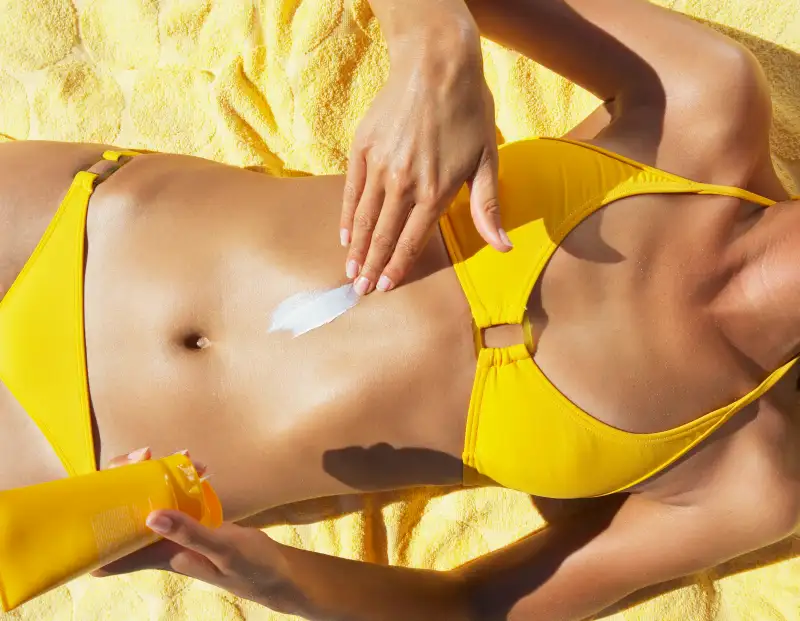SPF? UVB? PhD! The Complex Science of Sunscreen Shopping

Everybody knows that they should wear sunscreen to avoid sunburns and skin cancer. But apparently, you can't just slather on any old product. These days, the risks of using the wrong sunscreen are said to include hormonal imbalances, nanoparticle inhalation, and the outside chance of setting oneself on fire.
Hey, we were just getting the hang of the traditional acronyms associated with sunscreens—SPF (sun protection factor), UVA, UVB (the two varieties of ultraviolet rays). Now we also have to think about oxybenzone, avobenzone, and titanium dioxide, just to name a few. Because many of these scary-sounding chemicals are, indeed, tied to legitimate health concerns, the question is not Should I wear sunscreen? but, to paraphrase a Slate writer, Which sunscreen won't kill my kid?
In light of all the complications, the common-sense approach might just be to go with a well-known brand like Coppertone. In a post for the St. Louis College of Pharmacy, Abby Yancey, an associate professor at the school, explained that's what she did, sending a double pack of Coppertone spray with her child to daycare.
Then Yancey got an e-mail from the daycare service stating that children should not bring sunscreens containing oxybenzone. Sure enough, there was oxybenzone in the Coppertone. And when Yancey went back to Target, there was oxybenzone in pretty much every sunscreen in the store. What's so bad about oxybenzone? Yancey didn't know, so she Googled it—yes, even pharmacy college professors have to Google this stuff—and found out that it's absorbed into the skin, and some people "believe oxybenzone can cause hormonal imbalance" in users.
So there you are: Even pharmacists are flummoxed. Which would be reassuring if it weren't also frightening.
There are plenty of other sunscreen-related concerns to freak out about not mentioned by Yancey. Like, oh, the possibility that using spray sunscreen could mean you'll burst into flames, or at least get a bad burn—not a sunburn, a regular fire-type burn—if you're near an open flame, such as a barbecue grill. That's according to the FDA, which warns that because many of these products contain alcohol, which is flammable, "if you apply certain sunscreen sprays and then come close to a source of flame, you may risk the sunscreen catching fire and giving you a serious burn."
As for some other basics, such as the proper distance for applying spray sunscreen—again, far away from any open flames!—the experts aren't always on the same page. Yancey's post recommends that users "be sure to hold the container 4 to 6 inches from the skin." In the June issue of Health, meanwhile, Joshua Zeichner, M.D., the director of cosmetic and clinical research in the department of dermatology at Mount Sinai Medical Center in New York, says, "Hold the nozzle 1 to 2 inches away from the skin." At least everyone agrees that you should rub in the sunscreen after applying. (Ideally, not while you're also flipping burgers on the grill.)
Experts also tend to agree on something that seems rather disconcerting to the consumer who doesn't want to spend more than three seconds picking out a sunscreen: A lot of what's on store shelves should be avoided.
In the latest tests of 20 sunscreens by Consumer Reports, only two of the products provided the SPF protection claimed on their packages after the wearer was immersed in water. One of the sunscreens tested offered only half the claimed SPF after being in water.
After running its own tests, the Environmental Working Group (EWG) issued a guide promising that "Sun Safety Gets Easier," while offering a dire warning about the majority of products on the market:
Two-thirds of the sunscreens in our analysis don’t work well enough or contain ingredients that may be toxic. American stores are still stocked with inferior products.
The EWG "Easier" guide features page after page of alarming info, including the idea that many high SPF claims are misleading (SPF100 isn't twice as effective as SPF50), that Vitamin A, found in 20% of sunscreens, "may speed the development of skin tumors and lesions," and that mineral sunscreens, which are generally zinc oxide and titanium dioxide-based, and which actually get a favorable rating from the EWG and most experts, are of concern because they contain nanoparticles, which are dangerous if inhaled. (Side note: The FDA has also issued warnings about the dangers of inhaling spray sunscreens. And Consumer Reports notes that zinc oxide and titanium dioxide "have been linked to reproductive and developmental effects in animals.")
Even so, deep within the EWG guide, you'll find the seemingly straightforward recommendation: "Zinc oxide is EWG’s first choice for sun protection." Overwhelmingly, however, the EWG hammers home the point that every effort should be made to limit sun exposure and sunburn. "Don't depend on sunscreen," the study states. "People who rely on sunscreens tend to burn, and burns are linked to cancer."
Likewise, there's this shocking finding from CR:
Research shows that people who rely on sunscreens alone tend to burn more than those who stay in the shade and wear long sleeves.
Wow. Who would have guessed?
Seriously, for those who feel compelled to escape the shade occasionally, and who want to buy a sunscreen without having to get a PhD in chemistry, do the bare minimum and be sure the product has an SPF of at least 15, and that the FDA-approved phrase "broad spectrum" is on the label. That should help protect you from the most harmful rays. And take CR's helpful, common-sense reminder to heart: "Using any sunscreen is better than using none."
